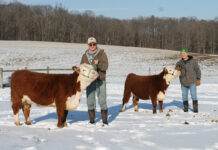COLUMBIA, Mo. — Owners of horses, mules and donkeys should keep their animals away from trees favored by eastern tent caterpillars.
Tent caterpillars
The eastern tent caterpillar, a native defoliator, typically appears in great numbers after a mild winter and wet spring, said Wayne Bailey, University of Missouri Extension entomologist.
When ingested by pregnant mares, these caterpillars can cause mare reproductive loss syndrome (MRLS), which results in the aborting of late-term foal fetuses, said MU Extension forage specialist Craig Roberts.
Bacteria
The caterpillar’s setae (hairs) are pointy hollow barbs that can penetrate the intestinal walls of the mare and introduce bacteria to susceptible organs, including reproductive organs and amniotic fluids.
“They can be in water or near water tanks, and horses swallow them as they drink,” Roberts said. “They can be on the ground and consumed during grazing.”
The caterpillars are most often found in the crotch or fork of wild cherry trees, wild plum trees and other ornamentals in the spring, said Bailey.
The eastern tent caterpillar is distinguished from other caterpillars by its opulent pearl-white stripe down its back and iridescent blue dots, he said.
Building tents
The caterpillars strip trees of their leaves after building a thick web nest or “tent.” They leave the nest when trees leaf out, then migrate to sites such as the sides of trees, debris on the ground, fences or sides of buildings, where they will spin cocoons.
There are several ways to manage the pest, Bailey said. Homeowners can simply collect the webbing and worms and burn them. Some might prefer environmentally friendly pesticides such as neem oil or Bt (Bacillus thuringiensis). For large areas or where infestation is intense, over-the-counter options include Sevin, which contains carbaryl. Caterpillar tents are water-repellent, so water-based insecticides will be ineffective.
In 2001, Kentucky’s horse industry lost an estimated $500 million when MRLS afflicted more than one-third of the state’s pregnant mares, even though the mares showed no symptoms of disease just weeks prior to aborting their fetuses.














Horses should not be around cherry trees at all under any circumstances… from what I understand they are poisonous to horses if the horse eats any part of it.
There are several other trees, Ranally, including cherry that can be toxic to horses. Great source of information in this link from eXtension.org:
http://www.extension.org/pages/42334/is-the-shrub-called-a-red-tipped-photinia-poisonous-to-horses-i-would-like-to-plant-it-close-to-a-fen
are these only on the east coast?
Hello,
According to Auburn University (http://www.ag.auburn.edu/enpl/bulletins/easterntentcaterpillar/easterntentcaterpillar.htm), eastern tent caterpillars occur in the eastern U.S. as well as west to the Rocky Mountains and north to southern Canada. Hope this helps!
Katie